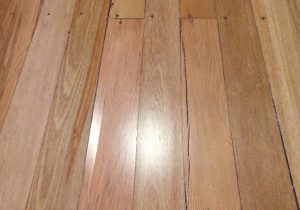Swinard Wooden Floors will sand and recoat your worn floor, we can add on to or alter the colour of an existing floor, as well as repair damaged timber floors. If you are selling your property, polyurethane or oil recoating will give your floor a much needed lift.
Recoating
Recoating will bring your floor back to life and eliminate the possibility of moisture seeping into high traffic areas – e.g. adjacent to kitchen sinks. Like all natural materials, wooden floors require maintenance to keep them protected and looking their best. We advise that this is done when the floor starts to look tired or worn, regular maintenance will increase the life span of your floor. See Floor Sanding, Coating and Finishing for further details.
- Polyurethane coated floors will be lightly sanded in order to key the existing polyurethane and then one or two coats will be applied.
- Oiled floors can be buffed and topped up with oil.
It is cheaper to recoat your floor at an early stage of wear than it is to restore a very worn floor.
When recoating an old floor with polyurethane, we would like to bring your attention to a number of things:
When
A buff or light sand should only have to “key” the polyurethane coating, remove the existing coating or at the most a very small portion of the wear layer, we can then apply a fresh coat. If you leave it until raw timber is exposed and discolouration has set in, we will have to sand off more of your wear-layer. Your floor can be fully sanded approximately 3 to 5 times, depending on the amount of wear and tear it receives and the depth of sanding that has to be done each time. Eventually the timber above the tongue and groove joint becomes too thin and the wood snaps off when walked on. These boards would have to be replaced or in many cases the whole floor. If left too long, we may not be able to remove discolouration.
Colour
Your existing polyurethane may well have yellowed over time and given your floor a uniform appearance. When we remove this we will reveal the original colour of your wood, with its natural tonal variations from light to dark. The new polyurethane is clear and so these variations remain visible – over time these differences will decrease.
Borer
Small pinholes in your floor are indicative of borer – either currently active in your floor or historically. The borer burrow through the wood and then pop out, creating the small hole. When we sand your floor we remove the top layer and expose the whole tunnel they have made inside the wood.
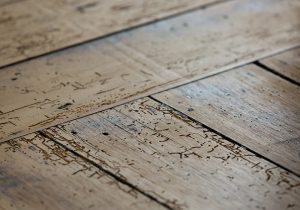
Exposed borer tunnels
Carpet Nails and Staples
Many old floors have had carpet installed over them in the past. When we know that a carpet has just been removed we will check and remove as many nails and staples as we can see. However, your floor may have been sanded previously and still have staples/nails deep within it. These cut into the sanding paper of our machines and can cause swirling marks in your floor. We will do our best to rectify this.
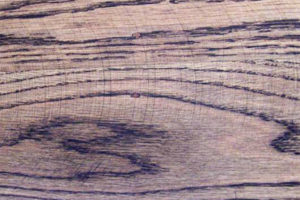
Sanding marks
Nail Corrosion
In some old floors, the fixing nails have corroded causing a small amount of black staining to the surrounding timber. This cannot be removed, except by removing the board. It does not affect the stability of the board. Some people find it visually unappealing, while others enjoy the markings of age.
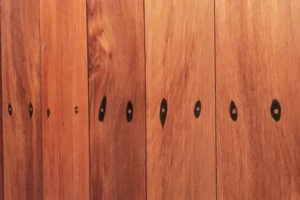
Nail corrosion
Stains
Larger stains are generally caused by spillages and leaking appliances. These can be of varying depths – shallow stains can sometimes be removed through sanding but deeper ones may mean that you have to replace the whole board.
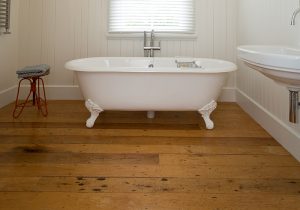
Stains
Wet Lines
Timber flooring is often installed throughout a house. If you sand and apply polyurethane to only a part of the timber floor (one room, for example) be aware that where the old and new polyurethanes meet, a wet line will be apparent. This is particularly noticeable when the floorboards run through the join in polyurethanes. Should the board run across the join, it is less visible. The two polyurethanes will be a different colour and sheen level; this is due to effects of the sun and UV, as well as wear and tear over time. We always recommend to sand and apply polyurethane to the entire timber flooring area.
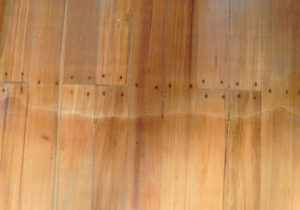
Polyurethane wet lines
Expectations
Remember that your current floor has furniture and/or rugs on it, which detract from the many small discrepancies that may be in your floor. When we finish re-coating your floor, it is pristine and clear of all household objects, this highlights these discrepancies. When you return your furnishings, they will become inconspicuous once more.
Timber flooring moves seasonally as it absorbs and releases moisture. Small gaps may appear between your floorboards as it does this. If you have chosen to have your flooring flood filled, the fill may well crack and fall out over time. There is nothing we can do to prevent this. Sanding and recoating an existing floor will not affect the stability of the floor or cause the timber to move.
Renovations
Should you be considering a renovation or extension to your house, Swinard Wooden Floors can add on to or reconfigure your existing floor. Whether it be plank, parquet, engineered or cork, we can restore a worn, scratched, dented or slightly damaged floor to its former glory.
We will do our best to identify your timber, match it or suggest something that will tie in. By fully sanding back the old and new flooring, we can bring it together as one. We can also darken or lighten timber floors and change the sheen level of coating. See Stains and Coatings. Our services can include punching in the nails, removing staples and/or glue, filling gaps (with either matching coloured filler or slithers of wood, depending on the size of the gap) and preparing a raw timber floor discovered during the renovation process.
If the flooring is to be replaced, we can uplift and dispose of your existing floor – timber, carpet, tiles or vinyl, etc. Be aware that some older vinyl products have an asbestos backing – this would need to be removed by an asbestos specialist.
Repairs
We can repair floors damaged by moisture, scratches and/or dents and can reaffix floors that have let go from the subfloor. We regularly undertake insurance work. Most floors are repairable, so please contact us to arrange a time to view your floor. If your floor is deemed irreparable we can suggest a replacement.
Common Issues
A perfect floor is everyone’s goal; however, there are many factors that can affect a timber floor once it has been installed. Wood is a natural product and seasonal influences, such as heating and cooling, result in a certain amount of movement. This is why all our floors are installed with expansion gaps around the edges. Exposure to heat sources, such as sun through large windows (without UV protection, blinds or curtains), vents from appliances, excessive or fast changing heating may all cause movement within your floor. Moisture, either unseen below the floor or from flooding above, will also affect it.
Gapping
Gapping is caused by damp timber drying out too fast or an extremely low humidity level within the home. A certain amount of gapping between floorboards is to be expected seasonally. It is the natural response of timber to dry conditions within the home. Reasonable shrinkage gaps between boards during dry times are acceptable – approximately 0.75mm for an 80mm board and proportionally wider for wider boards. This type of gapping will not necessarily be even throughout the floor as some areas can be affected more than others. As the dry conditions diminish, so should the gaps. However, excessive gapping needs to be looked at and remedied.
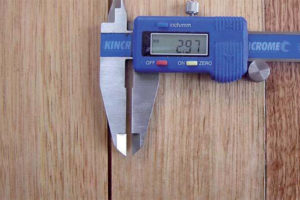
Gapping between floor boards
Cupping
Cupping is when the edges of the floorboard are higher than the centre. Generally it is moisture beneath the floor that causes cupping, but extreme heat or a very dry environment above the floor can also cause this. It is more prominent in wider boards. It will be necessary to investigate the cause of the cupping and to remedy this first, your floor may then revert to its pre-damaged state. If not, it may require repairing – only in extreme cases does it need a full replacement.
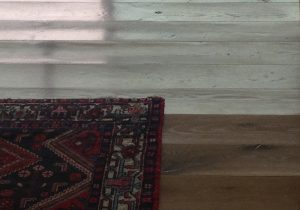
Cupping of floor boards
Peaking
Peaking has a similar appearance to cupping but is not so severe. It is caused by expansion pressure between the boards as it swells. It is generally caused by water from above, such as over-washing with too much liquid or a small but continuous leak from whiteware. First it is necessary to find the cause and remedy it, then give the floor time to dry out. Repairs may then need to be undertaken.
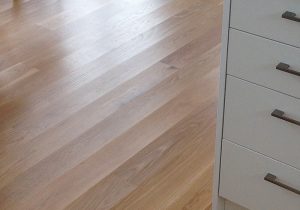
Peaking of floor boards
Crowning
Crowning is when the edges are lower than the centre of the board. This can happen if a cupped floor is sanded while still damp. When the timber dries out over time it will return to its previous state, minus the part that has been sanded off. Hence, why it is important to remedy the cause before you repair the floor. Once the cause is remedied you must still leave time for the floor to re-acclimatise to the new environment, before repairs can be undertaken.
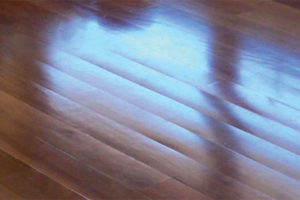
Crowning of floor boards
Squeaking
A small amount of noise is acceptable between floorboards installed over joists or battens. A timber floor can often be nosier during dry periods as the joints are looser. Floors that are Direct Fix or installed on an underlay should not squeak. If they are squeaking, then they may have insufficient expansion gaps or the glue has let go. This needs to be remedied.
Indentations
Depending on the hardness of your chosen timber you can expect to see indentations in your floor over time, for example as items are dropped or walked into it. It is important to remember that your floor is subjected to much heavier use than a piece of wooden furniture and its surface will show this.
To reduce indentations:
- place mats outside doors to ensure no stones are brought in on the soles of shoes
- remove shoes with stiletto heels
- take care when moving heavy objects (particularly fridges)
- place felt pads on the base of all furniture, particularly chairs
Small scratches can be considered part of the floor’s character. Bad scratches and indentations can be removed by sanding the wear-layer of your floor or replacing the board and re-applying your chosen coating – the deeper we have to sand, the more this reduces its lifespan. Our timber floors are able to be sanded 3-5 times, however a light sand and re-application of oil or polyurethane does not count as a full sand.
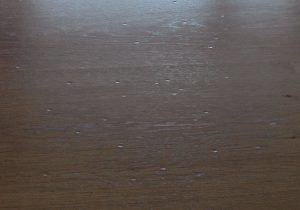
Stiletto heal damage
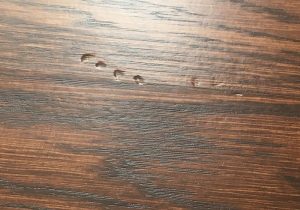
Indentations
Drummy Spots
Occasionally, when timber floors are laid on to concrete slabs, a drummy sound can occur under a few boards. This is rare but does happen. It could indicate that the glue has let go or that you have a slight hollow in your concrete subfloor. We can inject glue into this to reduce the sound.
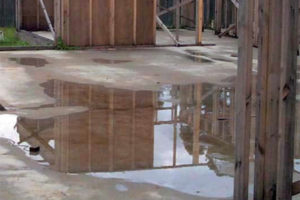
A hollow in a concrete subfloor
Block Parquet Flooring
Old glue can become dry and brittle; this can result in patches of wooden flooring blocks coming loose. These are a trip hazard and need to be reaffixed and the floor recoated. When we run our sanding machines over the entire floor many more may come loose. Therefore be aware that what sometimes looks like a small job, could be the beginning of a bigger issue.
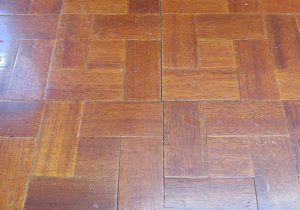
We’re experts at restoring floors
Concerns with wooden flooring can usually be easily remedied. It is important to consult a flooring repair specialist, such as Swinard Wooden Floors, as soon as you notice an issue.
Usually we need to ascertain where the moisture or excessive heat is coming from, and the quicker we can do this, the simpler the issue is to resolve.
You can also email us the details of the damage, and we will advise on how to treat the floor or suggest a site visit to assess it.
Let us know:
- what damage has occurred
- when you first noticed it
- the steps you have taken to resolve it
- the suspected cause
- submit photographs of your floor in its current state
We could advise on how to treat the floor or suggest that we come out and assess it. Once the cause has been addressed, it could be that you just need to allow the timber time to recover – it may return to its original state of its own accord. If not, you might need to contact your insurance company and arrange for us to view and draw up a quote.
Please remember that your current floor has furniture and rugs on it, these detract from the many small discrepancies that are in your floor. When we finish re-coating your floor, it is pristine and clear of all household objects, this highlights these discrepancies. When you return your furnishings, they will become inconspicuous once more.
Gaps Between Boards
Small gaps may appear between your floor-boards as the floor dries and moves seasonally. Wood absorbs and releases moisture and this is to be expected. If you have had your floor flood filled, the fill may well crack and come loose, requiring a simple re-fill. Sanding and applying polyurethane or oil to an existing floor will not affect the stability of the floor and would not cause it to move in any way.
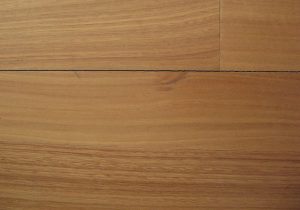
A gap between boards
Acclimatising Wood to your Environment
Timber flooring takes time to acclimatise to a new environment. Often it is recommended that the timber be allowed to acclimatise on site, prior to being installed. You need to bear in mind, what environment the timber needs to acclimatise to – an occupied home, not a building site. All our timber is kiln dried to a level which mimics the 8 to 10% moisture content level of the average Canterbury home. This environment is quite different to that of a building site, or an unoccupied building. It will take a full year for the timber to acclimatise to all seasons – this is clearly not possible. Once you move back into the house the environment will change as you heat or cool it seasonally – the timber needs to acclimatise to this. Give it time to acclimatise to its new home and if it doesn’t settle to the industry accepted standard, then we can address this.
A Floor at the end of its Life
Your floor can be fully sanded approximately 3 to 5 times, depending on the amount of wear and tear it receives and the depth of sanding that is required each time. Your floor may be nearing the end of its life when the timber above the tongue and groove joints become too thin and may snap when walked on. These boards would have to be replaced or in many cases the whole floor. If you regularly light sand and recoat your floor it will last longer; as it is only the polyurethane that is sanded back not the timber.
Where the polyurethane has been completely worn off over time, the timber can be sanded back to remove discolorations, along with the patches of polyurethane that remain in less worn areas. Regular maintenance ensures that your floor will be enjoyed for decades.
